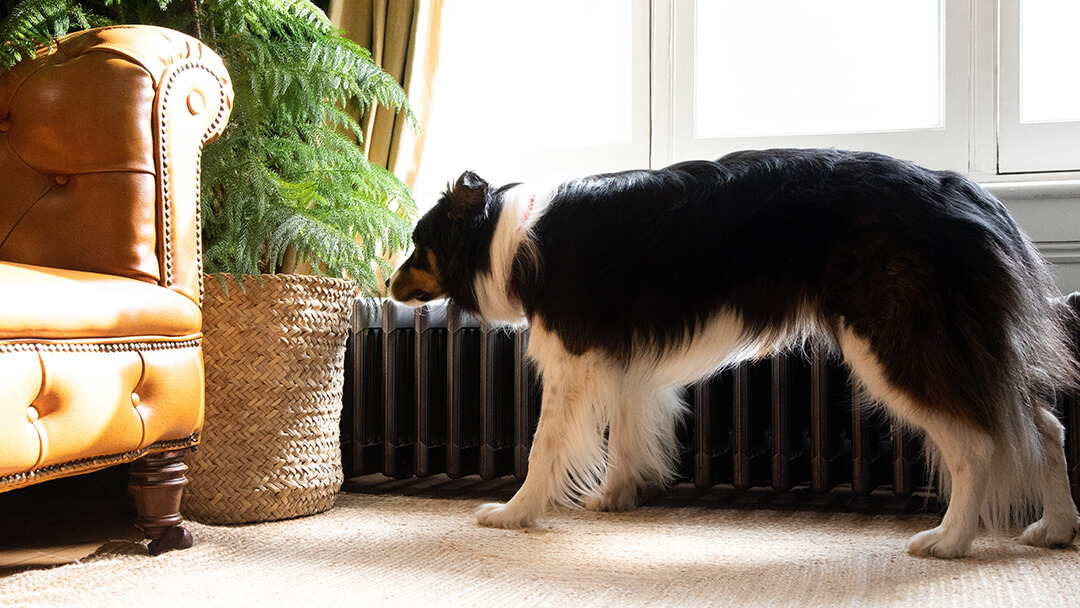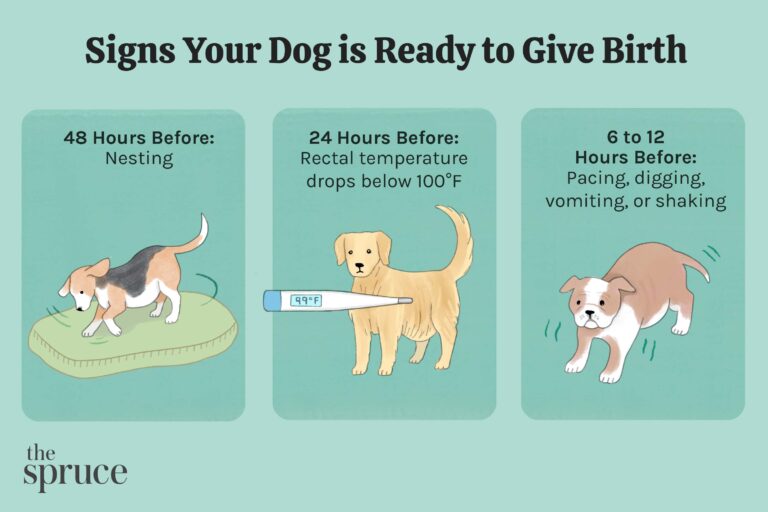To determine if your dog is in labor, look for signs such as panting, pacing, refusal of food, restlessness, and a drop in temperature. These behaviors may be accompanied by vomiting and changes in nesting behavior.
Additionally, you may notice an enlargement of your dog’s mammary glands and the production of milk. It’s important to create a comfortable nesting area for your dog and be prepared for the upcoming delivery.

Credit: www.purina.co.uk
Understanding Labor In Dogs
When it comes to a dog’s pregnancy, understanding the labor process is vital for pet owners. Being able to recognize the signs of labor in dogs can help prepare for the imminent arrival of adorable puppies. This article will guide you through the stages of labor in dogs, from the early signs to the final stage.
Signs Of Early Labor
- Drop in temperature
- Restlessness
- Changes in nesting behavior
- Vomiting
- Loss of appetite
- Shivering
- Panting
- Tiredness
One of the early signs of labor in dogs is a drop in temperature. Pay attention to any restlessness, changes in nesting behavior, vomiting, loss of appetite, shivering, panting, or tiredness that your dog may exhibit. These signs indicate that your dog is getting ready to go into labor.
Stage One Of Labor
Stage one of labor in dogs is characterized by restlessness and anxiety. You may notice your dog panting, pacing, refusing food, and possibly even vomiting. Nesting behavior also begins during this stage. It is important to provide a whelping box, if your dog is already accustomed to it.
Stage Two Of Labor
In stage two of labor, the actual delivery of the puppies takes place. The puppies are usually born headfirst, but some may come out tail first. They are enclosed in a thin sac, which the mother will remove to enable them to breathe. Additionally, after each puppy is born, the mother dog will pass an afterbirth (placenta), which she often eats.
Stage Three Of Labor
The third and final stage of labor in dogs is the delivery of the placenta. It is important for the mother dog to expel all the afterbirths to ensure the health and well-being of both herself and the puppies.
It is essential to monitor your dog closely during the labor process and seek veterinary assistance if there are any concerns or complications.

Credit: www.youtube.com
Preparing For Labor
As an owner, it is important to be prepared for when your dog goes into labor. There are a few key signs to look out for, including changes in behavior and physical symptoms. By monitoring these signs, you can ensure a smooth and safe delivery for your dog and her puppies. Here are some important steps to take in order to prepare for labor.
Creating A Whelping Area
One of the first steps in preparing for labor is creating a comfortable and safe whelping area for your dog. This area should be warm, quiet, and free from any potential hazards. You can use a whelping box or a designated area in your home, lined with soft bedding for comfort. Make sure this area is easily accessible for both you and your dog, and consider providing a heat source to keep the puppies warm.
Monitoring Temperature
A drop in body temperature is a significant sign that labor is near. It is important to monitor your dog’s temperature regularly as her due date approaches. A normal dog’s temperature is around 101 to 102.5 degrees Fahrenheit. When her temperature drops below 99 degrees Fahrenheit, labor is likely to begin within the next 24 hours. Keep a thermometer handy and record the readings to track any changes.
Monitoring Nesting Behavior
Another indication that your dog is getting ready to give birth is nesting behavior. This can include digging or scratching at the bedding, rearranging the area, or seeking out a secluded spot. Provide nesting materials such as blankets or towels for your dog to create her own comfortable space. Monitoring and encouraging this behavior can help your dog feel secure and prepared for labor.
Monitoring Appetite And Behavior
Just like humans, dogs may experience a loss of appetite before going into labor. Pay attention to your dog’s eating habits and note any significant changes. Additionally, observe her behavior for signs of restlessness, pacing, or panting. These can all be indications that labor is imminent. Keeping a close eye on your dog’s behavior can help you anticipate the arrival of the puppies and provide any necessary assistance.
By following these steps and monitoring your dog’s temperature, nesting behavior, appetite, and overall behavior, you can be better prepared for when your dog goes into labor. Remember, it is always recommended to consult with your veterinarian for guidance and assistance throughout the labor process. With proper preparation and care, you can ensure a safe and smooth delivery for your beloved pet.
Seeking Veterinary Assistance
If you’re wondering how to know if your dog is in labor, look out for signs such as restlessness, changes in nesting behavior, vomiting, loss of appetite, shivering, panting, and tiredness. It’s important to monitor your dog closely during this time and seek veterinary assistance if needed.
When To Seek Veterinary Assistance
If you suspect that your dog is in labor, it is essential to know when to seek veterinary assistance. While most dogs are capable of giving birth without any complications, there are situations where professional intervention is necessary. It is important to be vigilant and monitor your dog closely during the labor process. Here are some signs that indicate the need for veterinary assistance:1. Excessive Straining: If your dog is straining for more than 30 minutes without producing a puppy, it could be a sign of a problem. Prolonged straining can be an indication of a puppy being stuck in the birth canal or other complications that require immediate veterinary care.2. Green Discharge: If you notice a green discharge coming from your dog, it is a sign of fetal distress. This could mean that the placenta has detached prematurely or that the puppies are not receiving enough oxygen. Seek veterinary assistance immediately to prevent any harm to the puppies or the mother.3. Weak or Inactive Puppies: If a puppy is not moving or appears weak after being born, it could be a sign of a health problem. In such cases, it is crucial to consult a veterinarian who can assess the situation and provide the necessary care.Emergency Situations
Certain situations require immediate veterinary attention. If you observe any of the following emergency signs during your dog’s labor, do not hesitate to contact a veterinarian:1. Bleeding: Excessive bleeding or a continuous flow of blood from your dog’s vulva should be considered an emergency. This could indicate a ruptured uterus or other serious complications that require immediate medical intervention.2. Breathing Problems: If your dog is having difficulty breathing during labor, it could be indicative of issues such as a collapsed lung or fluid in the lungs. These conditions can be life-threatening and require immediate veterinary assistance.3. Seizures: Seizures during labor are a severe concern and should be treated as an emergency. They can be a sign of eclampsia, a potentially life-threatening condition caused by low calcium levels. Prompt veterinary care is crucial to save both the mother and the puppies.Post-delivery Care
Once the delivery is complete, it is essential to provide proper post-delivery care for your dog. Here are some tips to ensure the well-being of the mother and her puppies:1. Observe the Mother: Keep a close eye on the mother dog after delivery. Monitor her behavior and check for any signs of postpartum complications, such as excessive bleeding, fever, or refusal to eat. If you notice anything concerning, seek veterinary advice promptly. 2. Provide a Safe and Comfortable Environment: Create a warm, quiet, and comfortable whelping area for the mother and her puppies. Ensure that the area is free from drafts and other potential hazards.3. Monitor the Puppies: Watch the puppies closely for the first few hours after birth. They should be active, nursing, and gaining weight. If you notice any puppies not feeding or appearing weak, contact your veterinarian for guidance.Remember, every pregnancy and labor is unique, and seeking veterinary assistance when needed ensures the best possible outcome for both your dog and her puppies. Trust your instincts and consult a professional if you have any concerns.
Credit: www.facebook.com
Frequently Asked Questions Of How Do I Know If My Dog Is In Labor
How Do Dogs Act When Labor Is Near?
As labor approaches, dogs may show restlessness, pacing, panting, refusal of food, and possibly vomiting. They may also exhibit nesting behavior. Keep an eye out for these signs and consider placing your dog in a whelping box.
What Are The Signs Of A Dog Going Into Labor?
Signs of a dog going into labor include a temperature drop, restlessness, changes in nesting behavior, vomiting, loss of appetite, shivering, panting, and tiredness.
How Long Does The First Stage Of Dog Labor Last?
The first stage of dog labor typically lasts several hours. It is characterized by restlessness, panting, pacing, refusal of food, and maybe vomiting. This stage is when the dog’s body prepares for labor and contractions start to occur.
What Comes Out First In Dog Labor?
During dog labor, most puppies come out head first but some may come out tail first. They are born inside a sac, which the mother removes so they can breathe. After each puppy, the mother usually passes the placenta, which she may eat.
Conclusion
To ensure the safe and healthy delivery of your dog’s puppies, it’s crucial to recognize the signs of labor. Look for a drop in temperature, restlessness, changes in nesting behavior, vomiting, loss of appetite, shivering, panting, and tiredness. Once you notice these signs, it’s important to create a comfortable whelping box for your dog.
Remember, each dog’s labor may vary in duration, so stay patient. If you have any concerns or if complications arise, seek veterinary assistance. By understanding the signs of labor, you can provide the care and support your dog needs during this important time.



